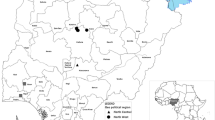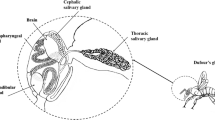Abstract
The ontogeny of the five queen mandibular gland semiochemicals that initiate and maintain the retinue behavior of worker honeybees was investigated by quantitative splitless capillary gas chromatography. No detectable pheromone is present at the time of eclosion, but decenoic acid levels build up rapidly during the first week of the queen's life. Two aromatic components attain detectable levels later, with the more plentiful methylp-hydroxybenzoate preceding the 4-hydroxy-3-methoxyphenylethanol. Pheromone levels are maximal in mature, mated, laying queens. The ratio of (R,E)-(−)-9-hydroxy-2-decenoic acid to the (S,E)-(+) enantiomer increases with the age of the queen. Pheromone levels in queen mandibular glands are largely unaffected by queen banking, restraint with workers in mailing cages, and limited storage on dry ice. All major body parts of typical queens, especially the head and legs, have sufficient mandibular exudate to be highly attractive to worker bees.
Similar content being viewed by others
References
Barbier, M., andLederer, E. 1960. Structure chemique de la “substance royale” de la reine d'abeille (Apis mellifica). C.R. Acad. Sci. Paris. 250:4467–4469.
Butler, C.G. 1961. The scent of queen honey bees (Apis mellifera) that causes partial inhibition of queen rearing,J. Insect Physiol. 7:258–264.
Callow, R.K., andJohnston, N.C. 1960. The chemical constitution and synthesis of queen substance of honeybees (Apis mellifera).Bee World. 41:152–153.
Crewe, R.M. 1982. Compositional variability: The key to the social signals produced by honeybee mandibular glands,in M.D. Breed, C.D. Michener, and H.E. Evans (eds.). The Biology of Social Insects. Proceedings of the 9th Congress of the International Union for the Study of Social Insects. Westview Press, Boulder, Colorado.
Crewe, R.M., andVelthuis, H.H.W. 1980. False queens: A consequence of mandibular gland signals in worker honeybees.Naturwissenschaften 67:467–469.
Free, J.B. 1987. Pheromones of Social Bees. Cornell University Press, Ithaca, New York.
Gary, N.E. 1962. Chemical mating attractants in the queen honey bee.Science 136:773–774.
Gehrke, C.W., andLeimer, K. 1971. Trimethylsilylation of amino acids. Derivatization and chromatography.J. Chromatogr. 57:219–238.
Howard, A.S., Michael, J.P., andSchmidt, M.A. 1981. Synthesis of 2-(4-hydroxy-2-methox-yphenyl)ethanol and 2-(2-hydroxy-6-methoxyphenyl)ethanol.S. Afr. Tydskr. Chem. 34:132–133.
Juska, A. 1978. Temporal decline in attractiveness of honeybees queen tracks.Nature 276:261.
Kaminski, L.-A., Slessor, K.N., Winston, M.L., Hay, N.W., andBorden, J.H. 1990. Honey-bee response to queen mandibular pheromone in laboratory bioassays.J. Chem. Ecol. 16(3):841–850.
Kandil, A.A., andSlessor, K.N. 1983. Enantiomeric synthesis of 9-hydroxy-(E)-2-decenoic acid, a queen honeybee pheromone.Can. J. Chem. 61:1166–1168.
Kaufman, K.D., andRussey, W.E. 1965. The Claisen rearrangement of resorcinol monoallyl ether.J. Org. Chem. 30:1320–1321.
Lombardo, L., andTaylor, R.J.K. 1978. An improved procedure for the conversion of carbonyl compounds to α,β-unsaturated carboxylic acids.Synth. Commun. 8:463.
Pain, J. 1961. Sur la pheromone des reines d'abeille et ses effects physiologiques.Ann. Abeille 4:73–152.
Pain, J., andRoger, B. 1978. Rythme circadien des acides ceto-9-decene-2-oique, pheromone de la reine, et hydroxy-l0-decene-2-oique des ouvriers d'abeilleApis mellifica ligustica S.Apidologie 9:263–272.
Pain, J., Roger, B., andTheurkauff, J. 1974. Mise en evidence d'un cycle saisonnier de la teneur en acides ceto-9-et hydroxy-9-decene-2-oique des têtes des reines vierges d'abeille.Apidologie 5:319–355.
Slessor, K.N., King, G.G.S., Miller, D.R., Winston, M.L., andCutforth, T.L. 1985. Determination of chirality of alcohol or latent alcohol semiochemicals in individual insects.J. Chem. Ecol. 11:1659–1667.
Slessor, K.N., Kaminski, L.-A., King, G.G.S., Borden, J.H., andWinston, M.L. 1988. Semiochemical basis of the retinue response to queen honey bees.Nature 332:354–356.
Winston, M.L. 1987. The Biology of the Honey Bee, Harvard University Press, Cambridge, Massachusetts.
Winston, M.L., Slessor, K.N., Smirle, M.J., andKandil, A.A. 1982. The influence of a queenproduced substance, 9HDA, on swarm clustering behavior in the honey beeApis mellifera L.J. Chem. Ecol. 8:1283–1287.
Winston, M.L., Slessor, K.N., Willis, L.G., Naumann, K., Higo, H.A., Wyborn, M.H., andKaminski, L.-A. 1989. The influence of queen mandibular pheromone on worker attraction to swarm clusters and inhibition of queen rearing in the honey bee (Apis mellifera L.).Insectes Sociaux, 36:15–27.
Zar, J.H. 1984. Biostatistical analysis, 2nd ed. Prentice-Hall, Englewood Cliffs, New Jersey.
Author information
Authors and Affiliations
Rights and permissions
About this article
Cite this article
Slessor, K.N., Kaminski, L.A., King, G.G.S. et al. Semiochemicals of the honeybee queen mandibular glands. J Chem Ecol 16, 851–860 (1990). https://doi.org/10.1007/BF01016495
Received:
Accepted:
Issue Date:
DOI: https://doi.org/10.1007/BF01016495




